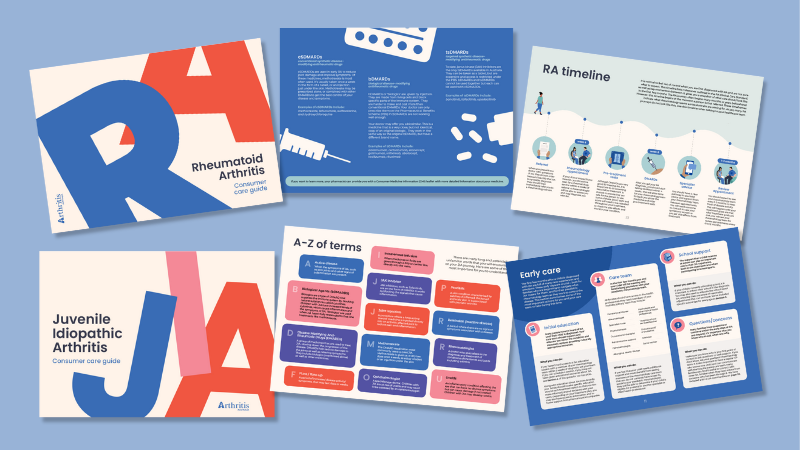Exercises for Arthritis
What’s the most recommended integrative therapy for arthritis? Exercise!
Be sure to ask your doctor about the safety of any CAM (complementary and alternative medicine), even exercise, before starting it to make sure it is right for you. Your rheumatologist may have already suggested that you get more active or exercise a few times a week. If you don’t know how to get started, ask your doctor, nurse, or physical therapist. They can give you a few tips so you can start exercising in a safe way for your body. It can be as simple as taking a walk or going to a warm-water pool class in your area.
Exercise can be FUN, even if you have arthritis. Find something you enjoy doing. Join friends or family members so you don’t have to exercise alone. A workout “buddy” can keep you motivated too. Crank up your favorite music. Work out while you watch a movie or talk shows.
Exercise Tips for When You Have a Flare
Listen to your body. Don’t do anything that adds more pain and discomfort, or could cause an injury. If you can do some kind of movement even during your flare, you may find that it can help. Break up your exercise routine into shorter segments. Or do something light that just gets you moving. Water exercise may be a good option during a flare, because you can move your joints without putting pressure on them.
Exercise or regular physical activity can help curb the symptoms of arthritis, including pain, stiffness, and lack of mobility. How do you get started? What kinds of exercise work best? It really depends on your symptoms, your overall fitness and health, and what kind of exercise you might like to do the most — because if you like doing an exercise, you’re more likely to keep doing it.
Below are suggested exercise options for people with arthritis.
Stretching
Daily stretching can help you manage your arthritis pain and improve your range of motion. After a three to five minute warm up (marching in place or arm circles), perform a variety of stretches and hold each for about 15 seconds. Reaching for the sky and touching your toes are good places to start. Don’t be afraid to stretch any joints that tend to be problem areas. Listen to your body — don’t push any stretch so far that it causes pain.
Walking
This simple exercise can fit easily into your daily routine no matter how old you are or where you live. It’s free — just find a safe place to walk in your area and get moving. Find some friends, neighbors, or family members to join you for a walk to make it even more fun. Walking can be good for your heart health, joint health, and mood.
If the weather is bad, you can walk inside your local mall. If it’s a pretty day, explore your neighborhood or local park. Walk on flat, paved surfaces to be safe. Make sure you have well-fitting, comfortable walking shoes and socks. Wear comfortable clothing that you can work up a sweat in. Drink some water beforehand or bring a small bottle so you don’t get dehydrated.
Start slowly and walk at an easy pace. As you feel more confident, challenge yourself to walk a little faster or farther, or both. Some people like to use personal fitness tracking devices (i.e. a FitBit or a pedometer) to track their daily activity and encourage consistent exercise.
Tai Chi and Yoga
Tai chi and Yoga are two ancient forms of movement. Tai chi is a series of flowing movements designed to help you improve function and balance. Yoga, which comes in many different styles, usually involves poses and stretches that are meant to improve arthritis symptoms and mood.
Both tai chi and Yoga are used by many people with arthritis to feel better and improve some of their arthritis-related symptoms. Done properly, both tai chi and yoga can be safe for people with arthritis to do on a regular basis. There are a number of arthritis tai chi and Yoga programs in local communities, as well as videos and online instruction tools.
You can also take a class from an instructor who can show you how to adapt your moves to be safe for your joints. Talk to your doctor or physical therapist to find out if tai chi or Yoga are right for you, and if they recommend any classes in your area.
Aquatic Exercise
Exercising in water is great if you have RA, because water’s buoyancy supports your weight so you can move around without putting lots of pressure on your joints. But water also offers some resistance as you move, so it can help you work your joints and muscles, and get stronger. Check out water exercise classes in your area, especially ones designed for people with arthritis. Your doctor or physical therapist can refer you to the right water exercise classes in your community.
Biking
People with arthritis have a higher risk of cardiovascular disease because of the inflammation involved in the disease. Riding a bike, either stationary or regular, can help rev up and strengthen your heart. It can also help you ease stiffness, improve range of motion or flexibility, and build endurance and muscle tone.
Strength Training
You can relieve the stress on joints damaged or weakened by arthritis if you build up the muscles around them. Strength training is the best way to do that. You can do specific exercises that target those muscles on your own, on a weight machine, or with small free weights. It’s important to do any strength exercises the right way, so talk to a physical therapist. Your PT can recommend strengthening moves for you and show you how to do them properly.





